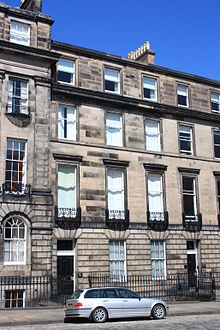Insurance Repairs
Following on from our water damage repair job to the properties at Ainslie Place where the customer wrote a fantastic testimonial regarding our works the insurance company have appointed us to complete the restoration of a damaged ceiling to another property in central Edinburgh in the New Town.
The ceiling we are working on was originally designed by the Architect Robert Playfair who designed lots of the properties in Edinburgh New Town when the houses were originally constructed this flat was also his own residence.
Extensive protection works are undertaken before we start the restoration of the damaged ceiling we have prepared an extensively detailed report with the loss adjuster very happy with our report and estimate. We started the works today, we are expecting the job to last 3 weeks as we arranged for the flat to be cleared of all furniture etc and got everything put into storage for the duration of the contract.
We have worked with the loss adjuster to organise everything taking all the stress from the insured who are delighted at how easy we made things for them we went through colour charts today with the insured and they have now chosen the colours and the make of paint we will utilise for the project.
As we are an all trades company with vast experience in dealing with insurance claims we are perfectly geared up to take on jobs like this and also water damage and fire damage claims.
If you require any assistance with an insurance claim contact us on our 24 hours 7 days a week on line from here or call us at our Edinburgh number 0131 240 5430 or my mobile number which is o7455777635 we are also on Facebook https://www.facebook.com/kingstonpreservation
William Henry Playfair.
William Henry Playfair FRSE (15 July 1790 – 19 March 1857) was one of the greatest Scottish architects of the 19th century,[1] designer of many of Edinburgh’s neo-classical landmarks in the New Town.
He was born on 15 July 1790 in Russell Square, London, to James Playfair and Jessie Graham.[2] Playfair’s father was also an architect, and his uncles were John Playfair, the scientist, and William Playfair, an economist and pioneer of information graphics.
Two of his finest works are the neo-classical buildings of the National Gallery of Scotland and the Royal Scottish Academy which are situated in the centre of Edinburgh. The Playfair Project completed in 2004 joined the two historic buildings with an underground link.
In the 1830s Playfair is listed as living at 17 Great Stuart Street on the prestigious Moray Estate in Edinburgh‘s west end.[3]
Playfair joined the Free Church following the Disruption of 1843,[4] losing his right to burial in the parish churchyard.
Playfair took David Cousin under his wing and was responsible for the latter part of his training.
Playfair died in Edinburgh on 19 March 1857, and is buried in the “Lord’s Row” on the western wall of Edinburgh’s Dean Cemetery, where he designed a number of monuments for others, including Lord Jeffrey.
Timeline of major projects

The unfinished National Monument, Edinburgh, begun in 1826

Fine detailing by Playfair on the Royal Scottish Academy
- 1817 Appointed architect to complete design work on the Old College, University of Edinburgh, on the basis of his proposals to complete the plans originated by Robert Adam. The building was completed around 1831.
- 1818 Commissioned by the will of the late Captain John McNabb to design the main building of Dollar Academy, a fitting structure with a Doric facade, which is now named after him.[5]
- 1820 Calton New Town, Edinburgh (includes Regent Terrace and Royal Terrace), completed only in 1860
- circa 1820 City Observatory, Calton Hill
- 1821–24 Royal Terrace, New Town, Edinburgh only completed in 1860
- 1822 Commissioned by the Institution for the Encouragement of Fine Arts in Scotland. The building was opened in 1826 and is now the Royal Scottish Academy Building, Edinburgh
- 1823 Royal Circus, New Town, Edinburgh
- 1824 in collaboration with Charles Robert Cockerell, designed an exact replica of the Parthenon which was to be built on top of Calton Hill as the National Monument, Edinburgh. However, due to lack of investment, it was never finished and became known as Edinburgh’s Disgrace.
- 1825 Regent Terrace, New Town, Edinburgh
- 1826 John Playfair Monument, (he was William Henry’s uncle), Calton Hill, Edinburgh
- 1827 – 1828 St Stephen’s Church, St Stephen’s Place, Silvermills, Edinburgh
- 1829 Drumbanagher House (demolished)
- 1830 – 1832 For the Royal College of Surgeons of Edinburgh, Surgeons’ Hall, Nicolson Street, Edinburgh
- 1831 Dugald Stewart Monument, Calton Hill, Edinburgh
- circa 1837 renovations to Floors Castle, outskirts of Kelso, Scottish Borders
- 1846 – 1850 New College, Edinburgh
- 30 August 1850 Prince Albert laid the foundation stone of the National Gallery of Scotland. adjacent to The Royal Scottish Academy.
- 1851 Donaldson’s College, Edinburgh
- 1852 Dunstane House – now a Hotel in west of Edinburgh
- 1859 National Gallery of Scotland opened to the public two years after Playfair’s death.
Gallery of architectural work
-
Donaldson’s College, Edinburgh 1851





















